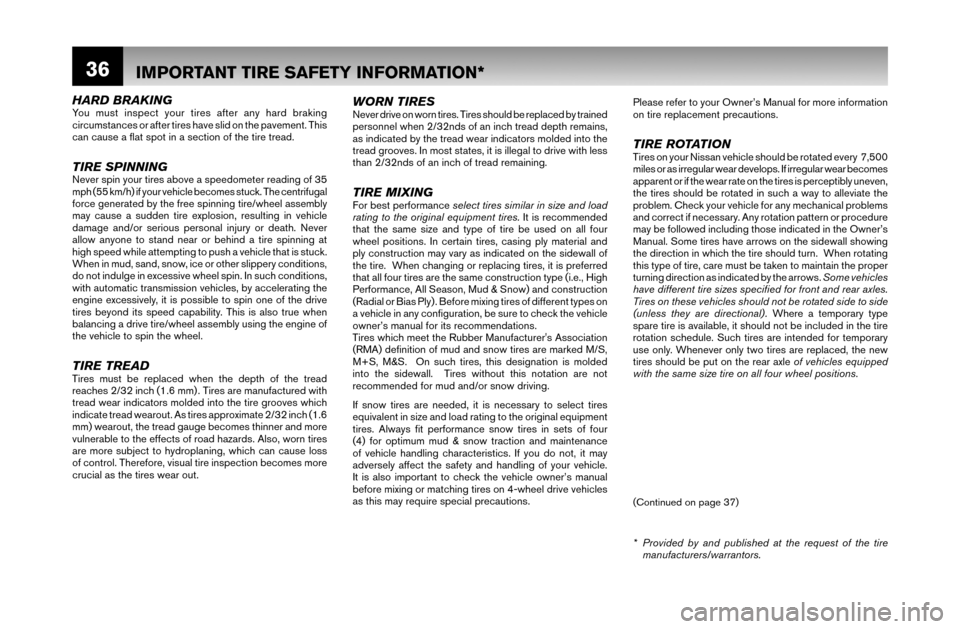traction control NISSAN SENTRA 2007 B16 / 6.G Warranty Booklet
[x] Cancel search | Manufacturer: NISSAN, Model Year: 2007, Model line: SENTRA, Model: NISSAN SENTRA 2007 B16 / 6.GPages: 55, PDF Size: 5.93 MB
Page 39 of 55

36
HARD BRAKINGYou must inspect your tires after any hard braking
circumstances or after tires have slid on the pavement. This
can cause a fl at spot in a section of the tire tread.
TIRE SPINNINGNever spin your tires above a speedometer reading of 35
mph (55 km/h) if your vehicle becomes stuck. The centrifugal
force generated by the free spinning tire/wheel assembly
may cause a sudden tire explosion, resulting in vehicle
damage and/or serious personal injury or death. Never
allow anyone to stand near or behind a tire spinning at
high speed while attempting to push a vehicle that is stuck.
When in mud, sand, snow, ice or other slippery conditions,
do not indulge in excessive wheel spin. In such conditions,
with automatic transmission vehicles, by accelerating the
engine excessively, it is possible to spin one of the drive
tires beyond its speed capability. This is also true when
balancing a drive tire/wheel assembly using the engine of
the vehicle to spin the wheel.
TIRE TREADTires must be replaced when the depth of the tread
reaches 2/32 inch (1.6 mm) . Tires are manufactured with
tread wear indicators molded into the tire grooves which
indicate tread wearout. As tires approximate 2/32 inch (1.6
mm) wearout, the tread gauge becomes thinner and more
vulnerable to the effects of road hazards. Also, worn tires
are more subject to hydroplaning, which can cause loss
of control. Therefore, visual tire inspection becomes more
crucial as the tires wear out.
WORN TIRESNever drive on worn tires. Tires should be replaced by trained
personnel when 2/32nds of an inch tread depth remains,
as indicated by the tread wear indicators molded into the
tread grooves. In most states, it is illegal to drive with less
than 2/32nds of an inch of tread remaining.
TIRE MIXINGFor best performance select tires similar in size and load
rating to the original equipment tires. It is recommended
that the same size and type of tire be used on all four
wheel positions. In certain tires, casing ply material and
ply construction may vary as indicated on the sidewall of
the tire. When changing or replacing tires, it is preferred
that all four tires are the same construction type (i.e., High
Performance, All Season, Mud & Snow) and construction
(Radial or Bias Ply) . Before mixing tires of different types on
a vehicle in any confi guration, be sure to check the vehicle
owner’s manual for its recommendations.
Tires which meet the Rubber Manufacturer's Association
(RMA) defi nition of mud and snow tires are marked M/S,
M+S, M&S. On such tires, this designation is molded
into the sidewall. Tires without this notation are not
recommended for mud and/or snow driving.
If snow tires are needed, it is necessary to select tires
equivalent in size and load rating to the original equipment
tires. Always fi t performance snow tires in sets of four
(4) for optimum mud & snow traction and maintenance
of vehicle handling characteristics. If you do not, it may
adversely affect the safety and handling of your vehicle.
It is also important to check the vehicle owner’s manual
before mixing or matching tires on 4-wheel drive vehicles
as this may require special precautions.Please refer to your Owner’s Manual for more information
on tire replacement precautions.
TIRE ROTATIONTires on your Nissan vehicle should be rotated every 7,500
miles or as irregular wear develops. If irregular wear becomes
apparent or if the wear rate on the tires is perceptibly uneven,
the tires should be rotated in such a way to alleviate the
problem. Check your vehicle for any mechanical problems
and correct if necessary. Any rotation pattern or procedure
may be followed including those indicated in the Owner’s
Manual. Some tires have arrows on the sidewall showing
the direction in which the tire should turn. When rotating
this type of tire, care must be taken to maintain the proper
turning direction as indicated by the arrows. Some vehicles
have different tire sizes specifi ed for front and rear axles.
Tires on these vehicles should not be rotated side to side
(unless they are directional) . Where a temporary type
spare tire is available, it should not be included in the tire
rotation schedule. Such tires are intended for temporary
use only. Whenever only two tires are replaced, the new
tires should be put on the rear axle of vehicles equipped
with the same size tire on all four wheel positions.
* Provided by and published at the request of the tire
manufacturers/warrantors.
IMPORTANT TIRE SAFETY INFORMATION*
(Continued on page 37)
57052 Booklet text pages.indd 3657052 Booklet text pages.indd 368/30/06 3:34:27 PM8/30/06 3:34:27 PM